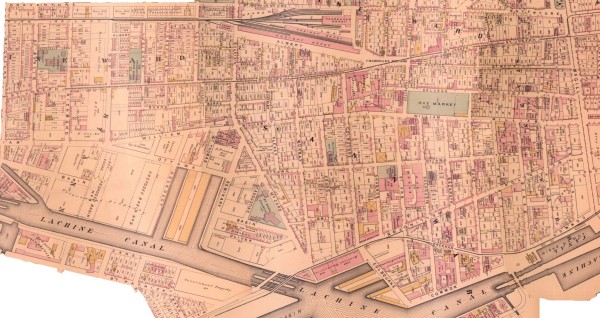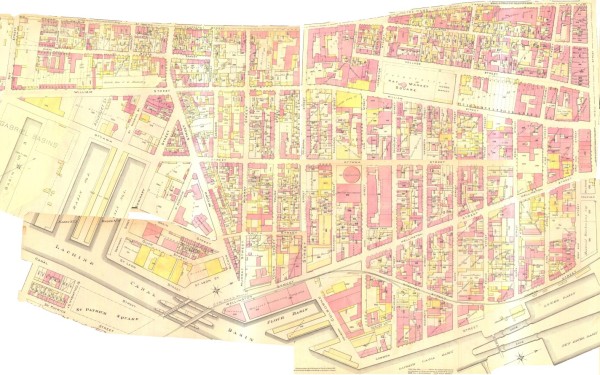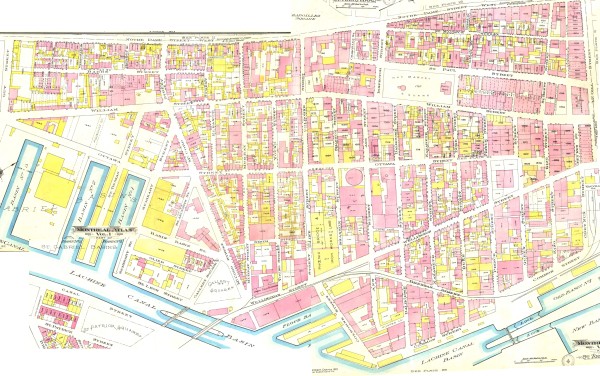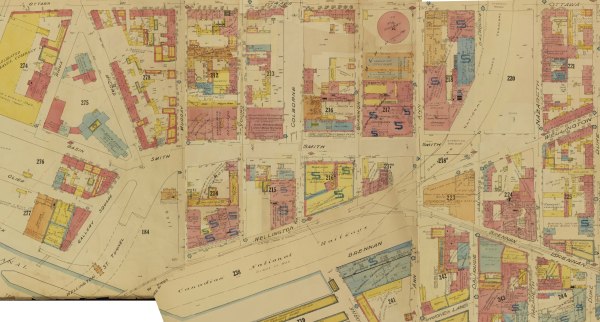A Cartographical History of Griffintown
(1860 to 1949) |
| Griffintown in 1879 |
 |
|
This 1879 map shows exceptional detail. Note that St-Gabriel Street is renamed to Ottawa after this city becomes the capitol of Canada. Kempt Street is renamed to Young. The Collège de Montréal, which occupied the area between William and College streets, is replaced by Hay Market Square and divided lots. The rivers/streams shown in the 1859 map are all absent. A tramway line of the Montreal City Passenger Railway Company appears along St. Joseph Street (present-day Notre-Dame). The Dow and Co. Brewery and Distillery occupies an entire block just off of Chaboillez Square. The cold storage facility, built around 1860, exists to this day.
|
| Griffintown in 1890 |
 |
|
By 1890, Basins 3 and 4 are completed near the intersection of Guy, William and Ottawa streets. They provide additional mooring space for ships and encourage the development of warehouses and other shipping industries in the vicinity. St-Joseph Street, the northern artery of Griffintown, is renamed to Notre-Dame. The Ottawa Street M. E. Church (corner St. Ann) is replaced with a Gazometer linked to the New City Gas complex. The row houses which exist on present day Mountain Street (then McCord) appear on this map opposite St. Ann's Church and Seminary.
|
| Griffintown in 1907 |
 |
|
Prevalent on this map are the tramway lines which run across Notre-Dame and Wellington and up McCord and McGill. College Street is renamed to St-Paul and the former college grounds are nearly completely developed east of the Hay Market. The first electrical substation in Canada, Montreal Light Heat and Power's "Poste Centrale-1", is built just north of Wellington between Prince and Queen. It was renamed "Poste Adélard-Godbout" in 2007. The Northern Electric Company complex is built opposite Basin 4 in 1906, and also exists to this day.
|
| Griffintown in 1914 |
 |
|
The Montreal and Southern Counties Railway terminus near the intersection of Wellington and McGill appears on this map. Starting in 1909, rail service on this line connected St. Lambert via the Victoria Bridge. By 1916, service reached as far as Granby. The area adjacent the Wellington Street Bridge is transformed into Gallery Square. The Phoenix Bridge and Iron Works Limited complex is shown occupying an entire block along Wellington between Colborne (now Peel) and Shannon streets. This company would provide the iron beams for the ill-fated Quebec Bridge.
|
| Smith Street and CN Viaduc in 1940 |
 |
|
Griffintown is sliced in half by the Canadian National Railways viaduct connecting the Victoria Bridge with a new downtown terminus: Central Station. Although expropriations and groundwork would commence between 1930 and 1933, the project was suspended for five years due to economic conditions, and would only be completed in 1943. The Wellington Tunnel replaced the 1893 swing bridge. Built as part of the public works effort of the Depression, the tunnel was the first of three under the Lachine Canal. Streetcars and automobiles ran through four tunnels. The approach to the tunnel was from Square Gallery which would be completely transformed. Wellington Street did not connect directly with the tunnel. Instead, Smith Street was widened and extended to connect with Wellington.
|
| Griffintown in 1949 |
 |
|
This map shows the completed CN Rail viaduct which decimates two blocks between Dalhousie and Nazareth streets, and cuts Hay Market Square in half. The completion of the viaduct and Central Station in 1943 rendered the Bonaventure Station terminating at Chaboillez Square obsolete, and it would be demolished in 1952. Notice that several buildings on the South side of the intersection of Ottawa and Shannon streets are absent. This is the result of the worst air disaster on the island of Montreal: on April 25th, 1944 a Liberator bomber crash landed shortly after takeoff from Dorval airport. 15 people were killed. The Henderson Barwick and Just Equipment Supply Co. buildings, which still stand today, appear on the Smith Street extension on opposite sides of Colborne (present-day Peel Street).
|
All maps on this page are available at Bibliothèque et archives nationales du Québec
|





